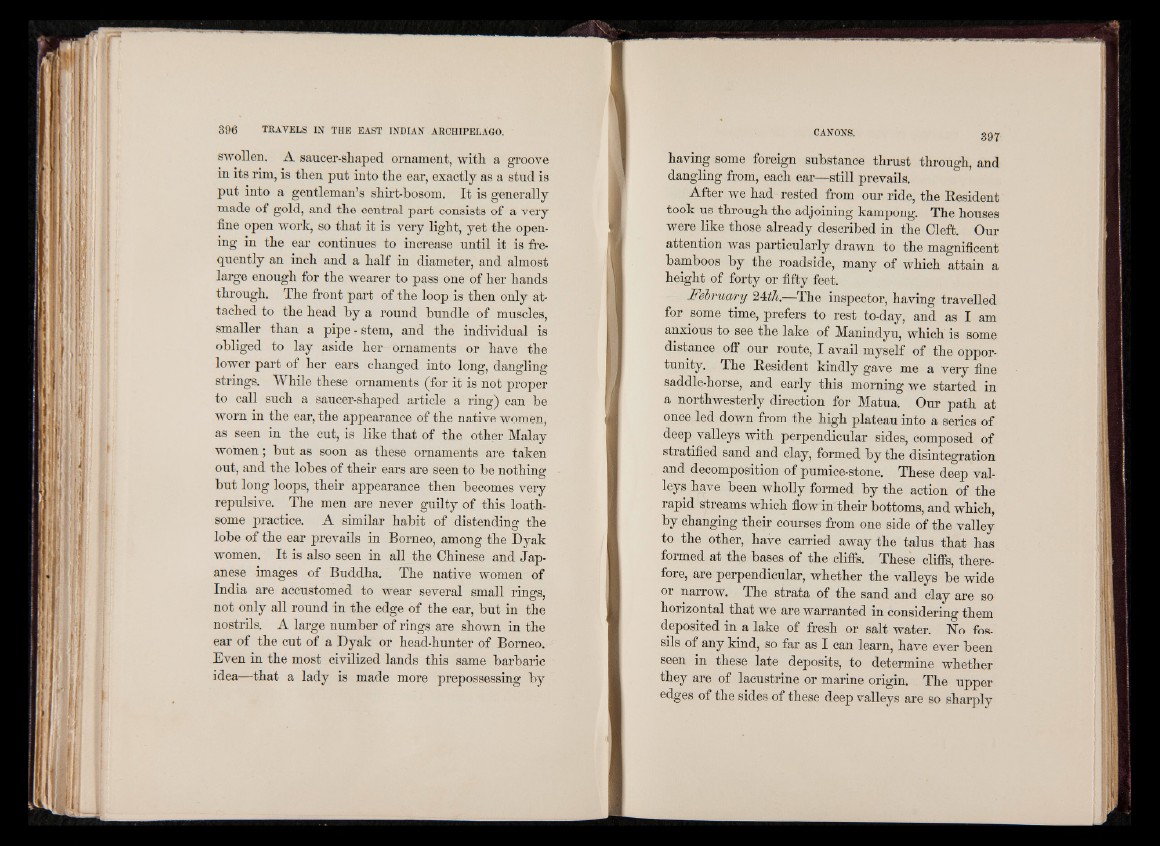
swollen. A saucer-shaped ornament, with a groove
in its rim, is then put into the ear, exactly as a stud is
put into a gentleman’s shirt-bosom. It is generally
made of gold, and the central part consists of a very
fine open work, so that it is very light, yet the opening
in the ear continues to increase until it is frequently
an inch and a half in diameter, and almost
large enough for the wearer to pass one of her hands
through. The front part of the loop is then only attached
to the head by a round bundle of muscles,
smaller than a pipe - stem, and the individual is
obliged to lay aside her ornaments or have the
lower part of her ears changed into long, dangling
strings. While these ornaments (for it is not proper
to call such a saucer-shaped article a ring) can be
worn in the ear, the appearance of the native women,
as seen in the cut, is like that of the other Malay
women; but as soon as these ornaments are taken
out, and the lobes of their ears are seen to be nothing
but long loops, their appearance then becomes very
repulsive. The men are never guilty of this loathsome
practice. A similar habit of distending the
lobe of the ear prevails in Borneo, among the Dyak
women. It is also seen in all the Chinese and Japanese
images of Buddha, The native women of
India are accustomed to wear several small rings,
not only all round in the edge of the ear, but in the
nostrils. A large number of rings are shown in the
ear of the cut of a Dyak or head-hunter of Borneo.
Even in the most civilized lands this same barbaric
idea—that a lady is made more prepossessing by
having some foreign substance thrust through, and
dangling from, each ear—still prevails.
After we had rested from our ride, the Resident
took us through the adjoining kampong. The houses
were like those already described in the Cleft. Our
attention was particularly drawn to the magnificent
bamboos by the roadside, many of which attain a
height of forty or fifty feet.
February 24th.—The inspector, having travelled
for some time, prefers to rest to-day, and as I am
anxious to see the lake of Manindyu, which is some
distance off our route, I avail myself of the opportunity.
The Resident kindly gave me a very fine
saddle-horse, and early this morning we started in
a northwesterly direction for Matua. Our path at
once led down from the high plateau into a series of
deep valleys with perpendicular sides, composed of
stratified sand and clay, formed by the disintegration
and decomposition of pumice-stone. These deep valleys
have been wholly formed by the action of the
rapid streams which flow in their bottoms, and which,
by changing their courses from one side of the valley
to the other, have carried away the talus that has
formed at the bases of the cliffs. These cliffs, therefore,
are perpendicular, whether the valleys be wide
or narrow. The strata of the sand and day are so
horizontal that we are warranted in considering them
deposited in a lake of fresh or salt water. No fossils
of any kind, so far as I can learn, have ever been
seen in these late deposits, to determine whether
they are of lacustrine or marine origin. The upper
edges of the sides of these deep valleys are so sharply